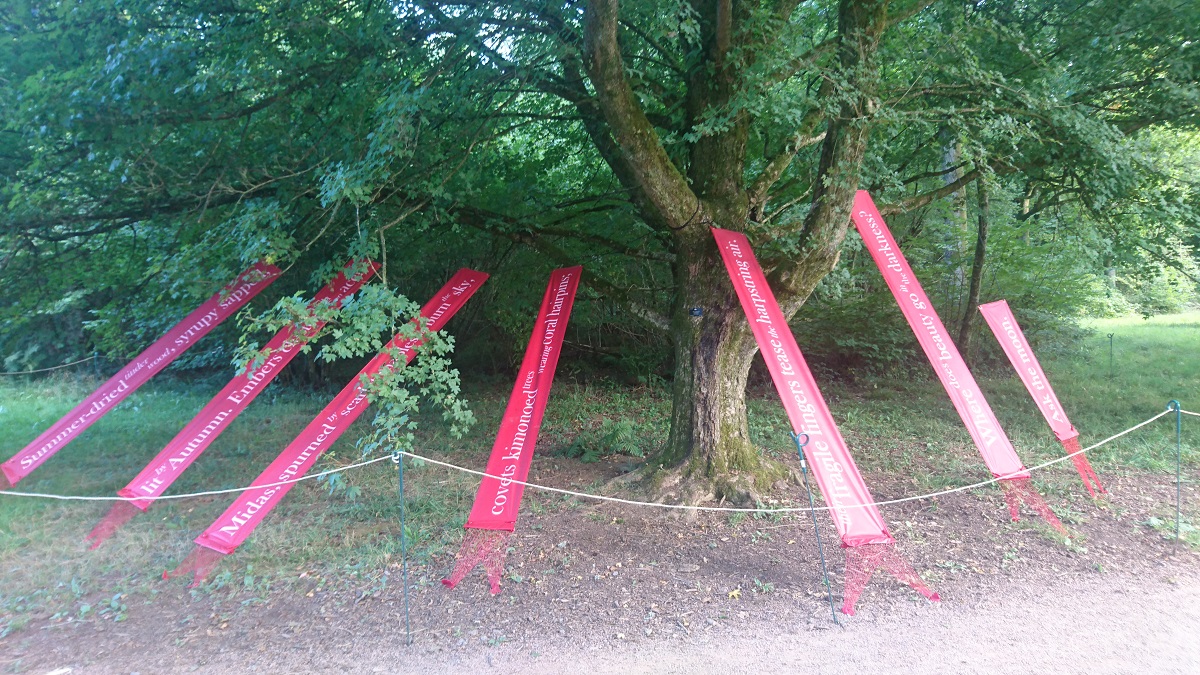
Smoulder is poem 3 on the Westonbirt Arboretum Autumn Trail 2017.
The audio version of this poem was read by Amy Robins.
Smoulder
Summer-dried tinder wood, syrupy sapped,
lit by Autumn. Embers cluster high on acer.
Midas, spurned by scarlet maples that burn the sky,
covets kimonoed trees wearing coral hairpins;
their fragile fingers tease the harpstring air.
Where does beauty go in the darkness?
Ask the moon.
Marchant's Notes on 'Smoulder'
This field maple has golden-yellow leaves in autumn, as if touched by Midas in the season of alchemy. This is an acer (Acer campestre postelense): I imagined it being the torch that lit the surrounding trees, fuelled by maple syrup – its sap.
I was given this field maple to hang my poetry on because it is not the main attraction; it overlooks the stunning 'Spreading Star' maples that flash crimson and scarlet in autumn. One of the Japanese words for maple is momiji which comes from momizu meaning 'to change colour, to become crimson-leaved.'
I imagined the field maple to be jealous of these surrounding, kimonoed trees. But in the darkness, where is beauty then? It was reading Pablo Neruda’s poetry collection 'Questions' that made me think a question would fit well here: “Where does beauty go in the darkness? Ask the moon.”
The smaller maples are Acer palmatum, named because of their five-lobed, hand-like leaves. The Japanese names also reflect the shape of the leaves: kaede – hands of frogs, momiji – hands of babies. Acer palmatum in Japanese is 'koto no ito' meaning 'harp strings'.
Here are a few of the poems about maples that influenced my writing of 'Smoulder':
“Ever more lavish as the dusk descends/ This glistening illuminates the air/… come autumn and its leaves will turn to flame” – Clive James, Japanese Maple.
“The maple… That turns to red, a stag horn shaped seed… Of yellowish hue yet beautifully green” – John Clare, The Maple Tree.
“Kiyoshi’s proud, elegant brushstrokes cut/ amongst the crimson like diving otters/ as each draft of summer wind arranged/ its own brief verse, only to discard it” – Paul Adrian, Kiyoshi and the Maple.
“the distant maple tree/ & her transformation under the moon from green to bold red” – Melanie Spencer – The Sacred Maple Tree.
“In the moonlight underneath/ the Japanese maple tree” – Roisin Sullivan, Japanese Maple Tree.
“Glowing flaxen and scarlet… there’s nothing more radiant/ than the sugar maple tree” – Cona Adams, Queens of Autumn Splendour.
“The harlot maples crimson tipped nails” – Debbie Guzzi, The Harlots of Spring
“Maple leaf sliding/ silently down to green earth/ red color prevails” – Cherie Boenemen, Maple Leaf (Haiku).
“Little fingers creep/ Make their way through wind’s soft touch/ Caressing summer air” – Jordon, Japanese Maple (Haiku).
“Nature’s bonfire burns on” – Gerard Manley Hopkins, That Nature is a Heraclitean Fire and the comfort of the Resurrection.
Silkwood Trail Display Board
By Ben Oliver
Colourful characters: As a group, maples (Acer) seem to revel in autumn. Flaming yellows, burnt oranges and fiery reds – as you wander round Westonbirt you’ll find a maple to suit every preference!
Most people know about chlorophyll; the ‘green stuff’ in leaves that captures sunlight and powers summer growth. In autumn chlorophyll production shuts down allowing the other leaf pigments to show their colours. Like an artist’s mixing palette, the balance of different pigments dictates what colour different trees turn. Leaves full of carotenoids turn yellow gold, red leaves contain anthocyanin – a mixture of the two will give orange.